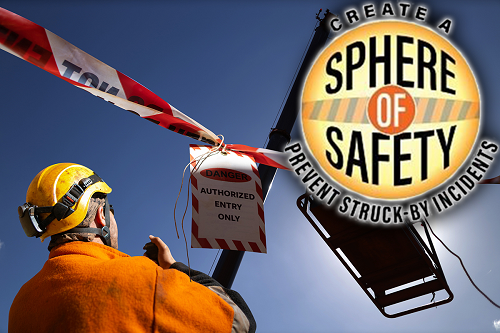
Struck-by incidents are a leading cause of death among construction workers, and since 1992, the leading cause of nonfatal injuries in the industry. The Occupational Safety and Health Administration (OSHA) defines struck-by incidents as those “produced by forcible contact or impact between the injured person and an object or piece of equipment.” These tips can protect construction workers from the four most common struck-by hazards: getting hit by a flying, falling, swinging, or rolling object.
1 Protect your head.
Each year, thousands of construction workers suffer a head injury, and hundreds die. Always wear head protection to protect from cuts, burns, bruises, traumatic brain injuries, and death.
2 Tether your tools to your work belt.
Construction workers are at twice the risk of struck-by injuries than those in other industries. Companies who have employees working at heights should have a tool tethering policy. Tool tethering is securing or attaching handheld tools to workers or anchor points. Always use tethers, lanyards, or other devices as required to prevent tools from falling on people and objects below.
3 Stay alert in work zones.
Getting struck by equipment is the leading cause of injuries and deaths in work zones. Never walk near large equipment unless the operator signals it is safe. Listen for alarms and horns. Obey signs and signals, and never stray into open traffic lanes.
4 Make internal and external traffic control plans.
In 2020, more than 22,000 traffic crashes occurred in road construction work zones in Texas, causing 186 struck-by deaths and 680 serious injuries. A well-designed Traffic Control Plan (TCP) can safely move motorists through a work zone using cones, barrels, signs, signals, or lane changes. An Internal Traffic Control Plan (ITCP) can protect employees inside the work area from being struck by construction vehicles and equipment. An ITCP should set up travel routes and delivery points inside construction zones and make sure that workers know the location of others at all times. For more information on safe TCP and ITCP areas, download the Texas Department of Insurance, Division of Workers’ Compensation (DWC) publication, Driving in Work Zones Fact Sheet.
5 Plan for a safe crane and lift zone.
From 2016 to 2020, 108 crane-related deaths occurred in the U.S. Over a third of these fatal crane injuries involved a worker getting struck by an object or equipment. Never stand under a suspended load, and always stay outside of the crane’s swing radius. Learn to “Rig it Right” by planning a load’s weight, dimensions, contents, pick points, and center of gravity. Keep a barricade around the crane at all times to separate workers and pedestrians from moving equipment.
For more information on construction struck-by hazards, review OSHA’s or The Center for Construction Research and Training's safety resources; or download or stream any of DWC’s free construction and fall prevention publications or videos.
